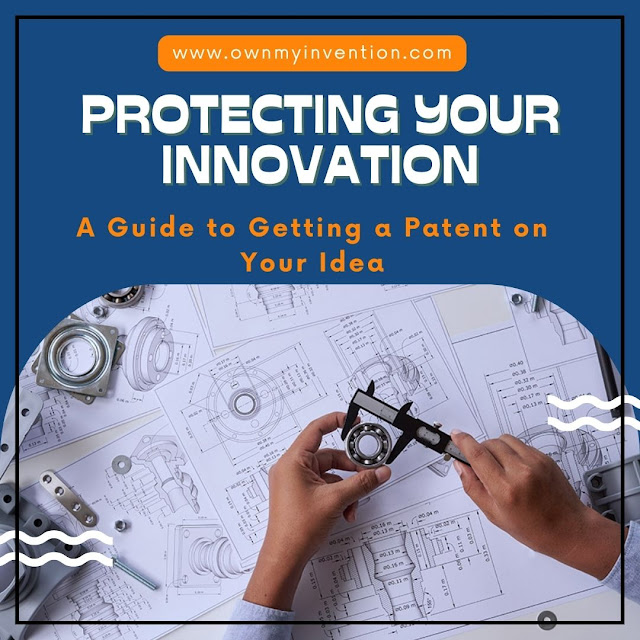Protecting Your Innovation: A Guide to Getting a Patent on Your Idea
Innovation drives progress, and every groundbreaking idea deserves protection. If you've come up with a novel concept, invention, or design, obtaining a patent is crucial to safeguarding your intellectual property rights. However, navigating the patent process can seem daunting. Fear not! In this comprehensive guide, we'll walk you through the essential steps to securing a patent for your idea.
Understanding Patents
First things first, let's demystify patents. A patent is a
legal document that grants its holder exclusive rights to an invention for a
specified period. This exclusivity allows inventors to prevent others from
making, using, selling, or importing their invention without permission.
Patents are crucial for fostering innovation by providing inventors with the
incentive to disclose their inventions to the public in exchange for
protection.
Assessing Patentability
Before diving headfirst into the patent process, it's
essential to assess the patentability of your idea. Not all inventions are
eligible for patent protection. To qualify for a patent, your idea must meet
certain criteria, including:
Novelty: Your invention must be new and not
publicly disclosed or available anywhere in the world before the filing date of
your patent application.
Non-obviousness: Your invention must not be obvious
to someone skilled in the relevant field. It should involve an inventive step
that is not merely a straightforward combination of existing technologies or
methods.
Utility: Your invention must have a practical
application and be useful in some way. It should serve a specific purpose or
solve a particular problem.
Conducting a Patent
Search
Once you've determined that your idea is likely patentable,
the next step is to conduct a thorough patent search. A patent search helps you
identify existing patents and publications that may be similar to your
invention. This step is crucial for assessing the novelty of your idea and avoiding
potential conflicts with existing patents.
Drafting a Patent
Application
With a clear understanding of the patent landscape, it's time
to draft your patent application. While you can technically file a patent
application on the patent company, seeking assistance
from a patent attorney or agent is highly recommended. Patent law is complex,
and a skilled professional patent help
companies can help you navigate the process and maximize the protection
for your invention.
Your patent application
should include:
Title and Abstract: A concise title that accurately
reflects your invention and an abstract summarizing its key features.
Description: A detailed description of your
invention, including its structure, function, and any variations or
embodiments.
Claims: The claims define the scope of
protection you are seeking for your invention. They should be clear, specific,
and supported by the description.
Drawings: If applicable, include drawings or
diagrams to illustrate your invention and its operation.
Filing Your Patent
Application
Once your patent application is drafted, it's time to file it
with the appropriate patent office. In the United States, the United States
Patent and Trademark Office (USPTO) oversees the patent application process.
Depending on your location and the markets you wish to target, you may also
consider filing for international patent protection through mechanisms like the
Patent Cooperation Treaty (PCT).
Prosecuting Your Patent
Application
After patent filing services,
your patent application will undergo examination by a patent examiner. The
examiner will review your application to ensure compliance with patent laws and
assess the novelty and non-obviousness of your invention. During this process,
you may receive office actions requesting additional information or amendments
to your application. Responding to these office actions promptly and
effectively is crucial to securing your patent.
Obtaining a Patent
Grant
If the patent examiner determines that your invention meets
all the necessary requirements, your application will be allowed, and you will
receive a patent grant. Congratulations! You are now the proud owner of a
patented invention. However, remember that obtaining a patent is just the
beginning. You must also maintain your patent by paying maintenance fees and
defending it against potential infringement.
Conclusion
Innovation is the lifeblood of progress, and patents play a
vital role in protecting and incentivizing inventors. By following the steps
outlined in this guide, you can navigate
the patent process with confidence and secure the protection your idea deserves.
As you embark on this journey, consider seeking assistance
from reputable patent services like Patent Services USA. Their expertise
and tailored support can streamline the patenting process, providing you with
the guidance and assurance you need every step of the way. With their help, you
can confidently navigate the complexities of patent law and ensure that your
innovative ideas are safeguarded for years to come.


.jpg)

Comments
Post a Comment